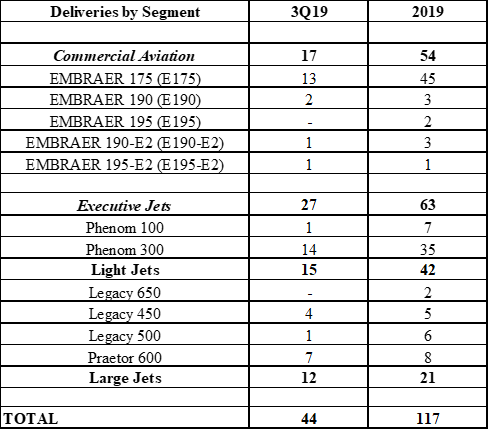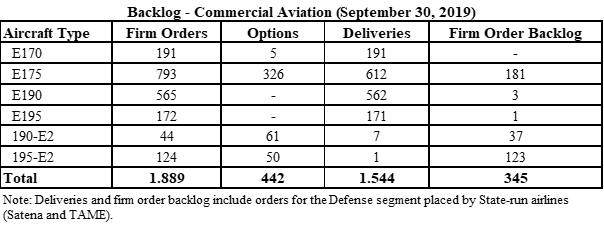Aviation
Embraer delivers 17 Commercial and 27 Executive Jets in 3Q19

São José dos Campos, Brazil, October 31, 2019 – Embraer (NYSE: ERJ; B3: EMBR3;) delivered a total of 44 jets in the third quarter of 2019 (3Q19), of which 17 were commercial aircraft and 27 were executive jets (15 light and 12 large). As of September 30th, the firm order backlog totaled USD 16.2 billion.

In the beginning of 3Q19, Embraer signed a contract with SkyWest, Inc. for a firm order of seven E175 jets in a 70-seat configuration. SkyWest will operate the aircraft for Delta. The order has a value of USD 340 million, based on 2019 list prices, and was already included in Embraer’s 2019 second-quarter backlog as an “undisclosed” customer. Deliveries are expected to begin in the fourth quarter of 2019.
In the third quarter, Embraer also delivered its first E195-E2, the largest of the three members of the E-Jets E2 family of commercial aircraft. The recipients were AerCap, the world’s largest aircraft leasing company, and Azul Linhas Aéreas Brasileiras. Azul is the global launch operator for the E195-E2 and had placed firm orders for 51 of the type. The airline will receive another five aircraft in 2019.

In the Executive Jets segment, Embraer announced a purchase agreement with Flexjet, a global leader in private jet travel, for a fleet of Praetor 500, Praetor 600 and Phenom 300 jets. The announcement was made during the 2019 National Business Aviation Association’s Business Aviation Convention and Exhibition (NBAA-BACE), in Las Vegas, Nevada. Valued at up to USD 1.4 billion, at current list prices, this deal was included in the 2019 second quarter backlog, with deliveries starting in the fourth quarter of 2019.
Also, the new Praetor 500 midsize business jet was granted the Type Certificate from three regulatory authorities: ANAC, the Brazilian Civil Aviation Agency (Agência Nacional de Aviação Civil); the FAA (U.S. Federal Aviation Administration), and EASA (European Aviation Safety Agency). Embraer has already received orders for the Praetor 500, including in Brazil. Also, Embraer delivered a Praetor 600 to its first Brazilian customer in 3Q19. In the Defense & Security segment, the Portuguese Government announced a firm order of five multi-mission Embraer KC-390 airlifters, representing the entry of the aircraft into the international market. The contract, which was signed at Embraer’s facility in Évora, Portugal, also includes services and support and a flight simulator as part of the process to modernize Portuguese Air Force capabilities to support national Armed Forces operations and increase readiness in missions of public interest. Deliveries are scheduled to start in 2023. This contract will be included in Embraer’s backlog in the fourth quarter of 2019.

Aviation
Boeing, Antonov to Collaborate on Defense Projects

– MOU represents Boeing’s commitment to work with Ukrainian industry
– Includes exploring opportunities for collaborating on in-country support of Unmanned Aerial Systems
A Memorandum of Understanding was signed today by Boeing and Antonov Company to investigate potential collaboration on defense-related projects.
“We’re happy to keep collaborating with the Antonov Company to help Ukraine’s economic development and expansion,” stated Ted Colbert, CEO and president of Boeing Defence, Space, & Security.
Airbus and the Antonov An-225: The Best Partnership:Click here
“This agreement demonstrates our ongoing efforts to find more opportunities to work with Ukrainian industry, which was underscored by our signing of the Ukrainian Defence Industry Compact earlier this year.”
The areas of potential collaboration identified in the agreement consist of training, logistical support and overhaul services for tactical Unmanned Aerial Systems utilized by the Ukrainian Armed Forces, which includes the ScanEagle. In addition, the companies will also explore opportunities for Antonov to provide engineering support to Boeing.
The six largest cargo aircraft ever built in the aviation industry:Click here
“A strong, innovative, and efficient defense industry is key to sustainable economic development and national security, and we are extremely excited to collaborate with Boeing,” said Ievhen Gavrylov, CEO of Antonov Company.
This agreement brings a whole new level of opportunity to implement the latest and most effective solutions – in addition to the possibility of future projects with Boeing in the aerospace and defense industry.”
-

 Travel1 week ago
Travel1 week agoAir India to Expand US Operations with Three New Routes After a Decade
-

 Travel2 weeks ago
Travel2 weeks agoWhy We Should Avoid These Stamps in a Passport
-

 Airlines1 month ago
Airlines1 month agoInvestigations Reveal Fake Chinese Titanium in Boeing and Airbus Jets
-

 Tech4 weeks ago
Tech4 weeks agoChina’s CATL Plans 1,800-Mile Electric Plane Launch by 2027
-

 Airport3 days ago
Airport3 days agoTop 10 Largest Airports in the World by Size
-

 Aerospace4 weeks ago
Aerospace4 weeks agoChina’s Fighter Jets Turn Wings into Autonomous Drones
-

 Airlines4 days ago
Airlines4 days agoAir India Rolls Out A350s for Delhi-New York JFK and Newark Routes
-

 Defence3 weeks ago
Defence3 weeks agoBoeing Enhances Chinook with New Engines and Block II Upgrades at $96 Million







